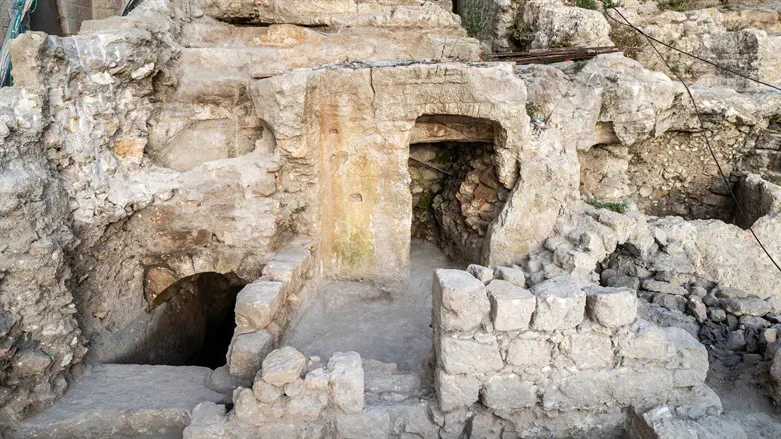
A salvage excavation near the Temple Mount by the Hebrew University of Jerusalem’s (HU) Institute of Archaeology has unearthed a unique ritual bath (“mikveh”) dating back to the Late Second Temple period (1st Century CE).
These excavations, begun in February 2021 to provide handicap access between Jerusalem’s Old City and the Western Wall, were overseen by HU’s Michal Haber and Dr. Oren Gutfeld, funded in part by Israel’s Ministry for Jerusalem Affairs and the William Davidson Foundation, and spearheaded by the Company for the Reconstruction and Development of the Jewish Quarter of the Old City of Jerusalem.
The ritual bath was found within a private villa, hewn into the bedrock and featuring a vaulted ceiling with fine masonry typical of the Herodian period. It is located on top of a cliff in the “Upper City”—a phrase coined by historian Josephus Flavius to describe the area of Herod’s City which housed Jerusalem’s elites. A plastered water cistern was uncovered near the same villa. It had been in use until the destruction of the Second Temple by Rome in 70 CE, and held the remains of nearly 40 cooking pots, some still intact.
In addition to the ritual bath, the excavations unearthed additional artifacts that span the Second Temple, Roman-Byzantine and Ottoman periods, including a network of plastered pools and channels. Among the finds were a section of the Ottoman-period phase of the “Lower Aqueduct” which transported water from Solomon’s Pools near Bethlehem all the way to the Temple Mount in Jerusalem during the Second Temple period; and an industrial pool built by soldiers of Rome’s Tenth Legion who were stationed in Jerusalem after the establishment of the Roman colony of “Aelia Capitolina” in 130 CE.
The pool lies on top of the remains of an earlier Roman oven, also installed by soldiers of the Legion. The bottom contains a layer of tile bricks, one of which was stamped with the letters “LXF,” alluding to “Legio X Fretensis,” the full name of the Tenth Legion.
Also discovered over the course of excavation was a fragment of Late Byzantine-period ceramic oil lamp, inscribed with the Greek formula "The Light of Christ shines for all." This phrase may have its source in the ceremony of the Holy Fire, part of the Orthodox Easter celebrations in the Church of the Holy Sepulchre. Such oil lamps, dated primarily to the 6th and 7th centuries CE, may have been purchased by Christian pilgrims thronging to the Byzantine city -- by now known as “Hierosolyma.”
Ze'ev Elkin (New Hope), Israel’s Minister of Construction and Housing and of Jerusalem Affairs, inaugurated the Western Wall Elevator Project, noting, “These rare finds, made during the Western Wall Elevator Project excavations, are truly exciting. They provide proof of a continuous Jewish presence in Jerusalem for millennia. Under my leadership, Israel’s Ministry of Jerusalem Affairs and Heritage will continue to preserve and develop Jerusalem’s rich Jewish past and to transform the capital into a modern, innovative city.”
Surveying the unique finds, Gutfeld shared, “The excavation revealed remains dating from the Second Temple, Roman-Byzantine, and Ottoman periods. The amount of water channels, cisterns, and pools discovered in the area reflect the central role played by Jerusalem’s water supply throughout the ages.”
As noted, the highlight of the archaeological dig was the ritual bath. Haber explained the significance of this find, saying, “During the Herodian period, the area in question was home to the city’s wealthiest residents. While several other ritual baths have been unearthed in the area, the importance of this particular discovery stems from its striking proximity to the Temple Mount—raising the question of who lived in this grand villa on the eve of the city’s destruction. It may well have been a priestly family.”
Together with the help of Dr. Amit Reem, chief archaeologist of the Israel Antiquities Authority’s Jerusalem District, the ritual bath will be preserved and incorporated into the new Western Wall Elevator complex.














